Forty-one years ago, I set out with a high school friend to travel around Europe and beyond. This is the fourth article in a five-part series that looks at my yearlong journey which would eventually determine my life as a photo journalist and adventurer. In this segment, I travel to the Greek island of Crete and walk 150 kilometers along the south coast to the small town of Matala, made famous by hippies in the 1960s and 70s. I made my debut in photography on this trip using an Olympus 35RD rangefinder camera with a fixed 40mm f1.7 lens.
Text and Photographs by Norbert Schiller
After traveling through Egypt for over a month, I returned to Athens where I took the ferryboat to Crete. My intention was to hike down the Samaria Gorge, a spectacular canyon that starts high in the island’s mountains making its way to the Mediterranean and then discover the lore behind the caves of Matala, a hippy haven in the 1960s and 70s.
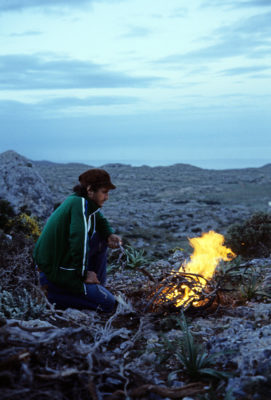
Dave making a campfire during our trek to the end of a desolate peninsula on the northwestern corner of Crete
In Crete, I hooked up with Dave who had just spent a month attending a survival skills workshop in Kenya. Dave was intent on trying out what he had just learned and convinced me to join him on a journey to a part of the island which was isolated from civilization. We took a bus to Afrata, a tiny village at the far northwestern corner of Crete where we stocked up on basic food supplies like bread, feta cheese, and candy bars. From there, we headed on foot for the end of the peninsula which, on the map, showed no roads, villages, or signs of human settlement. Supposedly, there were ancient ruins and a water well along the way. We reached our destination three days later, but found neither the ruins nor the well, so we were forced to boil stagnate rainwater that sat in pools full of little creatures called ostracods. For dinner one night, Dave came up with a concoction he called ostracods soup which consisted of a package of dehydrated pea soup he had carried in his pack since Kenya, stale bread, and feta cheese. He boiled the mixture in a pot and it tasted halfway good.
After our hike, we went to the town of Chania where we parted ways. Dave went back to the mainland to attempt some impossible trek which would be a more rigorous test for his newly-acquired survival skills, and set I off for the high mountains at the center of the island to hike down the Samaria Gorge. My idea was to trace the footsteps of my oldest friend, Will Triggs, who had done this trek two years before me. I also wanted to stay in a cave frequented by young travelers near the tiny port of Agia Roumeli, which could only be accessed on foot or by boat.

The snow-caped White Mountains as seen during my descent into the Samaria Gorge. I had to remove my shoes where the gorge narrows to three meters in order to continue. An Ottoman fort overlooks the mouth of the Samaria Gorge and the tiny port of Agia Roumeli on the southern side of the island
It was the end of March when I began hiking down the gorge. I had been warned about the high water at that time of year, but since I didn’t want to wait any longer, I decided to take my chances. The walk down was stunning. In the distance, the high peaks were still covered in snow and, since it had just rained, everything was green. When I neared the bottom of the canyon, I explored the abandoned village of Samaria and continued to the very end where the trail meets the water. The path was easy to navigate until I reached the part known as the Gates, where the gorge narrows to about three meters rising to a height of almost 300 meters. There, I had to take off my shoes and wade through knee-deep water until the gorge widened.
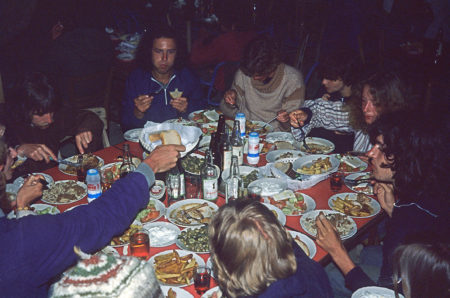
For my 21st birthday a group of German medical students treated me to dinner and drinks.
When I reached Agia Roumeli I asked about the cave, which I could see in the distance, and was told that it was going to be turned into a bar/disco, so I found a place in an open field where I set up camp. I spent a few days there exploring the countryside, including an old abandoned Ottoman castle overlooking the sea. From Agia Roumeli, I headed east following a footpath that hugged the coastline. For the next few weeks I hiked from one village to another along the southern coast until I reached Matala and its infamous caves. During my 150-kilometer trek, I met an interesting array of fellow travelers, some of whom became good friends. I camped on deserted beaches or on the outskirts of villages. Some mornings, I awoke to the sound of goats crashing through the underbrush, while other times I was shaken out of my deep slumber by the hollow sound of church bells. I stopped in every village to buy supplies and meet up with fellow travelers over a meal or a beer before continuing on my way. On April 2, my 21st birthday, I awoke in some abandoned stone house feeling lonely to be spending this milestone by myself. As I packed my gear and began walking, I ran into a group of German medical students on spring break. After an afternoon of rock climbing, my new friends treated me to a lavish meal in a nearby village, which was an incredible treat for someone like me who had been traveling on a shoe-string budget.

Hiking in the mountains with my new friends, the German medical student.
In the village of Plakias, I spent a few days painting a disco in return for room and board, but I was fired from my job for not wanting to spend my days doing labor work. Luckily, the German medical students showed up and invited me to climb the nearby mountains. From Plakias, the shoreline became difficult to navigate, so I got a ride from a traveler on the back of his motor scooter. Unfortunately, I didn’t realize that he had no idea how to ride a motorbike. A few kilometers into the journey, he made a sharp turn on the gravel sending us both into a ditch by the side of the road. Luckily, my backpack cushioned my fall, and the driver seemed to be fine as well. However, after that misadventure I decided to continue on foot.
As I got closer to Matala, I started running into European hippies or freaks, as they liked to be called. When I arrived to the village of Ayia Galini, I was immediately welcomed by a group of German freaks who invited me to their campsite across the river. The only problem with that location was that every time I wanted to go into town I had to take off my shoes and roll my pants above the knee to cross the stream. During daylight hours, it was no problem, but late at night, after a few bottles of wine, it was quite a challenge. I also met Doug, from the U.S., who joined me on the last leg of my walking journey to Matala. At one point, we took off all our clothes and hiked naked along the beach calling ourselves the “liberated backpackers.” When I returned to the U.S., Doug and I kept in touch and even took a trip together in his home state of Washington.
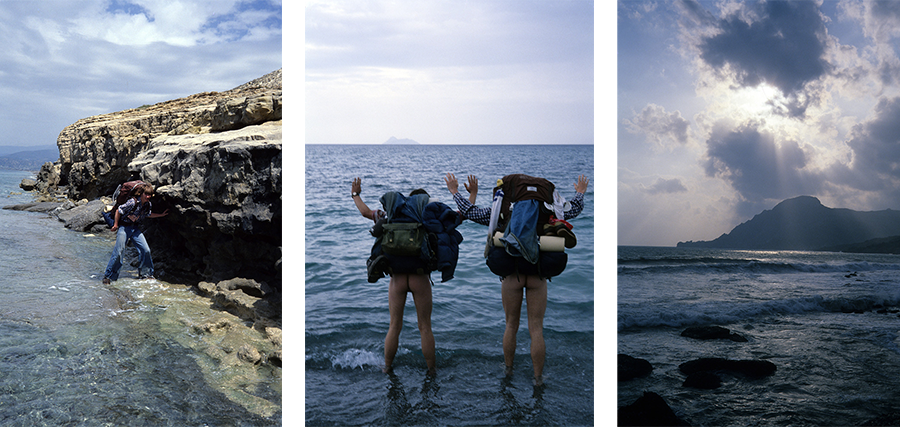
Doug walking along the coastline during the final stretch to Matala. During the trek, Doug and I removed our clothes and called ourselves the “liberated backpackers.” The sun appears through the clouds after a passing storm.
The first thing that struck me when we got to Matala was the strange mixture of young freaks, hanging on to the last vestiges of the hippie generation, and the middle-class northern European holidaymakers in search of sun. The two didn’t mingle preferring to stick to their respective spots on the beach and their favorite restaurants.
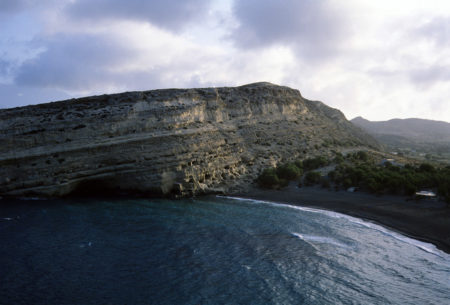
The view, from our cave, of the bay and the cave tombs of Matata made famous by hippies in the 1960s and 70s
As soon as we arrived and sat down at one of the cafes, we met with Zom, who I had heard about a few days earlier. Zom, originally from England, had been a vagabond for all of his adult life and had lived in Matala for periods of time over the past decade. He was considered a guru of sorts to many of the young freaks, and he loved to tell stories about his adventures while following the hippie trail from Turkey to India. As we had nowhere to stay, Zom invited us to his cave on the cliff across from the famous Roman tomb caves where hippies from all over the world had settled in search of an alternative lifestyle. The caves, now off limits to visitors, have been immortalized by Joni Mitchel, the singer and songwriter, who mentions her stay in Matala in her 1971 hit song, Carey.
Come on down to the Mermaid Cafe
And I will buy you a bottle of wine
And we’ll laugh and toast to nothing and
Smash our empty glasses down
Let’s have a round for these freaks and these soldiers
A round for these friends of mine
Let’s have another round for the bright red devil, who
Keeps me in this tourist town
The House of Zom, as we called our new home, was a magnificent naturally formed cave that had a view of the entire bay. The cave was also home to two German girls who seemed to be always tripping on Acid. Zom called them his “lost puppies,” and looked after them. Every evening, just before sunset, our favorite little restaurant would blare the song ‘Freak Out (Le Freak)’ by the American band Chic. It was a signal for all the freaks camping on the surrounding hillside to converge onto town for the night’s festivities.
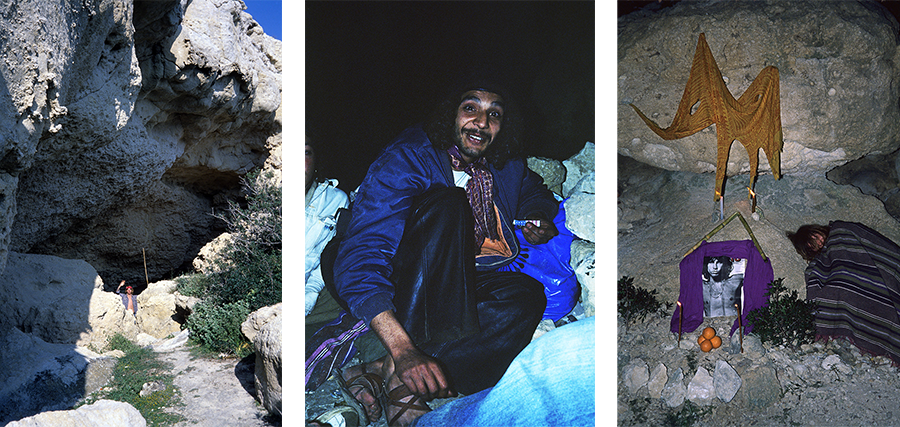
Doug standing outside our cave, which we called “the house of Zom.” Our host, Zom, recounting one of his incredible journeys. One of the German girls sleeping beside a memorial she and her friend had set up inside our cave to Jim Morrison, the late lead vocalist for the rock group The Doors, who died in 1971.
When I visited Matala, it was a very transient place. Gone were the days when hippies would settle down in one of the Roman tombs for months or even years at a time. Zom told me about a German couple who had spent two and a half years living in a cave where their first baby was born.
Our days in Matala were spent lounging on the rocks, swimming in the sea, and hanging out at our favorite cafe. It seemed like everyone was high on LSD except for Doug and I, so one day I asked Zom if I could try a tab of Acid. “You’ve never tried olives?” he asked with a curious grin on his face, “Everybody should try them. I should have offered you one much sooner.” With that, I popped a microdot size tab in my mouth and sat on a rock staring out at the sea not sure what was going to happen. For the next 8 hours, I took the most amazing hallucinogenic trip I had ever experienced.

I took two photographs while tripping on acid. I snapped the first shot while I stared out at the sea shortly after taking the hallucinogen, and the second image 8 hours later while the sun was setting.
Ten days into my stay in Matala, everyone I knew, including Zom, was slowly leaving for other destinations, so I decided to take off as well. After saying my goodbyes, I jumped on a bus to Heraklion, on the other side of the island, and took a ferry back to Athens from where I would prepare for my next adventure to Turkey.
